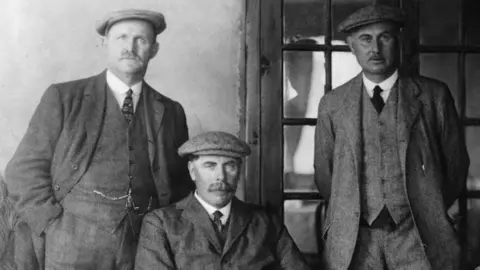 BBC
BBCVenue: Royal Troon Dates: Thu 18-Sun 21 July
Coverage: Live radio and text commentary on BBC Sport website, with video clips each day. Daily highlights programme on BBC Two from 20:00 BST. Click for full details.
“Magnificent, marvellous, humble James Braid”.
Regarded as one of the most successful golfers and course designers in the sports’ history, Braid’s legacy lives on more than 100 years since he refined one of the most respected par threes in golfing folklore – Royal Troon’s 8th hole, The Postage Stamp.
After winning the Open Championship five times, a feat only four other players have accomplished, the son of a farm manager in Earlsferry, Fife, went on to either create or influence around 400 golf courses across Europe.
Today, with The Postage Stamp playing its part again in the 152nd Open, Marjorie MacKie, 97, remembers the golfer, course-architect and her grandfather.

“He was a very pleasant man and not a loud man at all with a sparkle in his eyes,” Marjorie remembers.
“He loved his golf and he was able to play it every day, so that was all he wanted and he did it all his life”.
With a playing style described as “divine fury”, Braid was a gentleman on and off the course.
After winning his first Open at Muirfield in 1901, he moved to England to be Walton-Heath’s first professional golfer in her maiden year as a club.
He would stay there for the rest of his life and often stay with his family whenever designing or reshaping a Scottish course.
“He’d be talking more about the family he’d come to see rather than golf when he came to our house,” Marjorie says.

Braid was the first player to win five Open titles.
He was the only European player, until Dubliner Padraig Harrington matched the achievement in 2008 at Royal Birkdale, to successfully defend the championship when he did so in 1906.
A fine accomplishment considering two other greats shared the golf course with him in the late 19th and early 20th Century – Harry Vardon and John Henry Taylor.
Between 1894 and 1914, the trio dominated the Open Championship, winning 16 of the 20 competitions before the outbreak of World War One,
This earned them the grand title of “The Great Triumvirate”.

The three men fought hard and fairly on the golf course, but in the clubhouse, it was a different matter.
“They were great friends,” Marjorie says.
“I think that all added to the enjoyableness of his life when he was playing these Open championships… That gave him a lot extra.
“If he hadn’t had that relationship with the two other golfers [Taylor and Vardon], he would still have been very valiant golfer himself, but he got more enjoyment I think [with them]”.
Marjorie has a smile on her face when she’s thinking of them together.

When asked if they had any inclination that Braid would be thought of as one of the most important influences on golf, Marjorie answers, laughing: “None whatsoever.”
In fact, it wasn’t until she was in her late eighties that Marjorie realised that he wasn’t just her grandfather – he is a golfing legend.
“I had that photograph hanging there,” Marjorie says as she points to a Vanity Fair portrait.
“An elderly gentleman came to see us – he’d been a great man… He did a lot in both World Wars and I thought a lot of him.
“He sat down and saw this picture, the Spy caricature of my grandfather, and he said ‘Who’s that man up there?’
“I said that’s my grandfather, James Braid. He said ‘Right, I’ll stand up to that!’ and he stood up straight, this little old man.
“I realised if he knew about him and thought that much of him, he was important because, of course, he was never boasted about by his son and daughter-in-law. They were just family,” Marjorie remembers proudly.

She adds: “We were just pleased to know when he won anything because he was grandpa, that was all.
“I’ve always enjoyed the fact that people thought a lot of my grandfather because I just thought he was a nice man.
“I just loved him as my grandfather.”


